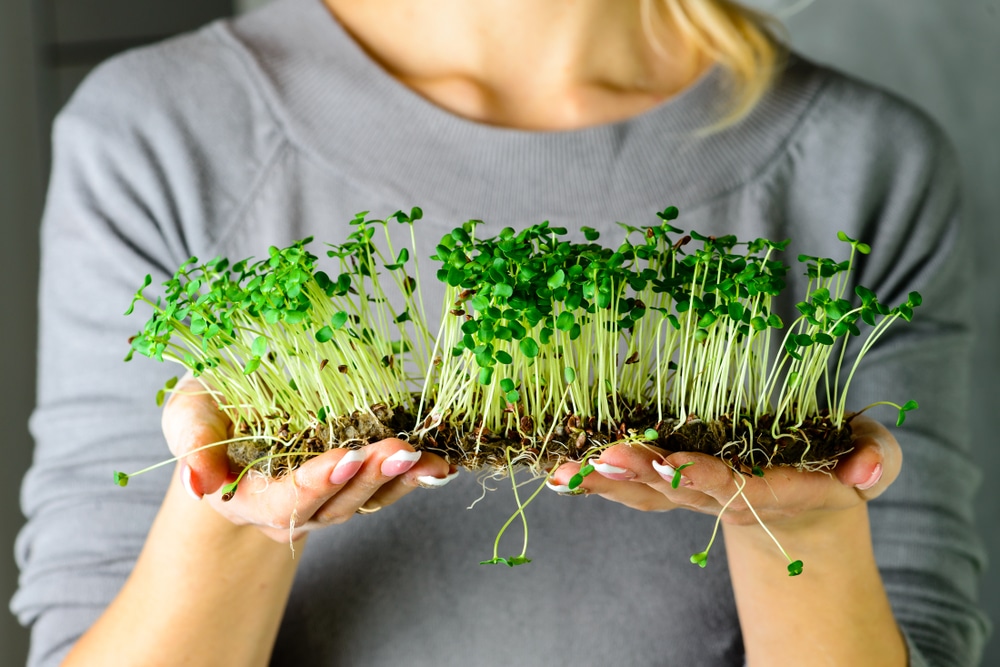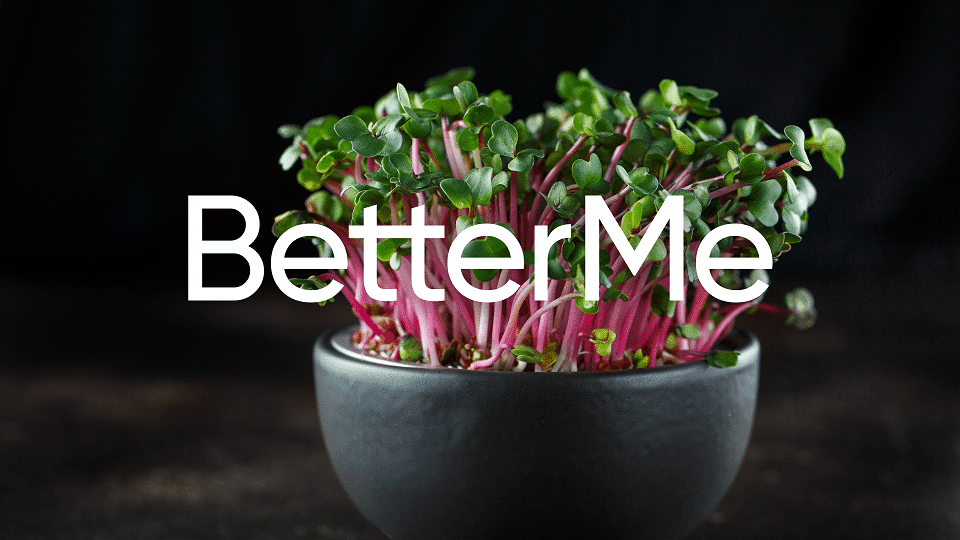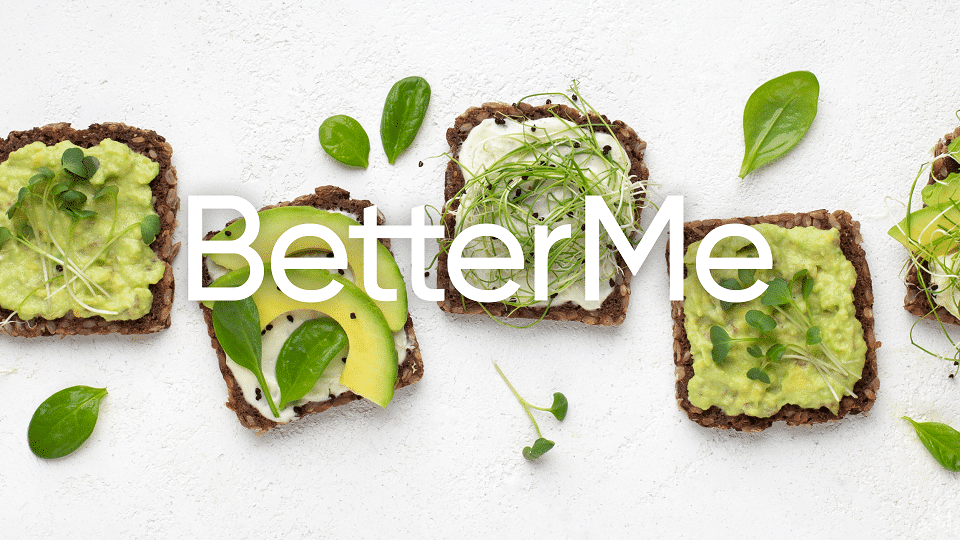Micro herbs, vegetable confetti, or simply microgreens. These wondrous little herb plants – all of which are harvested at around 10 days old – have gained popularity over the past few decades as people look for ways to add more vegetables and herbs to their diet. These mini, edible plants offer a concentrated level of nutrients that many other greens just don’t have. They make a perfect garnish for almost any dish and can be eaten alone as a snack or salad. You don’t have to fuss over them much at all either! Perfect for the casual gardener who doesn’t want too much hassle in their life. So what are microgreens benefits and why should you consider having them in your diet? This article will explore all that and more. So let’s get started!
Get your personalized
meal plan!
What Are Microgreens?
Microgreens are essentially very young versions of common vegetables like cabbage, mustard greens, kale, spinach and broccoli. These plants usually germinate in soil or in a pot with their first set of leaves unfurling in 14 days or less. They are typically harvested before they are 3 weeks old.
Most people confuse microgreens with sprouts, but there is a considerable difference between these two plants. Sprouts have a much shorter growing cycle of 2-7 days. Microgreens on the other hand are harvested 7-21 days after germination after the plant’s first true leaves have emerged.
Different Types Of Microgreens
Microgreens can be grown from many different types of seeds. Some of the most common are sunflower, buckwheat, alfalfa, broccoli, clover and radish. These seeds can be purchased at your local garden center or online. Popular types of microgreens usually have lots of color variations including purple, green, yellow-green and bronze.
Nutritional Value Of Microgreens
Let’s get to the good stuff right away – the most important thing about microgreens is that they offer a high concentration of vitamins and minerals due to their short growth cycle. A serving size of around 2 tablespoons contains as much as 9 times the nutritional value of a mature plant or a full-grown vegetable.
Some of the most important vitamins, minerals and antioxidants found in microgreens include lycopene, lutein, zeaxanthin, beta-carotene and sulforaphane – all of which contribute towards a healthy immune system and help fight against chronic disease (3).
They are also rich in potassium, iron, zinc, magnesium and copper (3). The exact nutritional profile varies from one particular microgreen to the other.
The microgreens with the most nutritional value include:
- Mustard greens – these plants have lots of vitamin A, C and K along with folate and iron. They also offer a source of omega-3 fatty acids which is good news for your heart.
- Alfalfa – these tiny green plants are packed with calcium, potassium and vitamin A. They also contain tons of antioxidants like zeaxanthin & lutein which help the eyes stay healthy.
- Broccoli – among microgreens, broccoli offers some of the highest amounts of calcium out there while still delivering vitamins A and K which keep your bones strong.
- Radish – these spicy veggies are high in vitamin C and B6, as well as calcium and magnesium – all essential for a healthy immune system.
Read More: Collard Greens Calories, Benefits, And Side Effects
Health Benefits Of Microgreens
Eating vegetables in general is good for your health. However, microgreens pack an extra punch because they contain more concentration of beneficial nutrients. Although the number of studies directly measuring the effect of microgreens on certain medical conditions is limited, and none could be found in humans, knowing their nutritional content can help draw specific conclusions about the potential of microgreens. They provide a number of possible health benefits, including:
Protection From Heart Disease
Microgreens are a rich source of polyphenols, a group of powerful plant compounds that help fight high blood pressure, high cholesterol and obesity (3).
Protection From Cancer
The high concentration of sulforaphane contained in microgreens has the potential to protect cells from oxidative damage which is one key contributor to cancer. In addition to this, microgreens also contain large amounts of carotenoids – another group of antioxidants which may help fight against cancer (3).
On top of this, the high levels of calcium and magnesium found in microgreens help keep bones strong, possibly reducing your risk of developing osteoporosis (3).
Slows Aging Processes
Over time, free radicals cause damage to the cells in our body which can lead to premature aging. As mentioned above, microgreens are packed full of antioxidants which help fight free radicals, thus possibly slowing down the aging process (5).
Protects from Alzheimer’s Disease
The high levels of vitamin B, folate and choline in microgreens are believed to help slow down cognitive decline (especially when combined with regular exercise).This makes them perfect for elderly people who want to fight back against Alzheimer’s disease (2).
Improve Digestion
As green leafy vegetables contain high amounts of fiber, they also help keep your digestive system healthy and working properly. This in turn helps prevent bloating, constipation and other related problems (3).
Furthermore, the anti-inflammatory properties in microgreens could help relieve symptoms of constipation, diarrhea and inflammatory bowel disease (IBD) (3).
Saves Eyesight
Eating microgreens that are rich in beta-carotene and other carotenoids may help reduce your risk of developing age-related macular degeneration (AMD) (3).
If you wish to free yourself from all the extra pounds that have been weighting you down for way too long, start using the BetterMe app and overhaul your entire life!
Prevents Anemia
The iron content in microgreens is a great way to help prevent anemia, especially the type caused by iron deficiency (3).
Boosts Energy
Microgreens are a great source of antioxidants, B-vitamins and omega-3 fatty acids which fight stress and help the body turn food into usable energy (3).
Reduces PMS Symptoms
The high levels of calcium and magnesium in microgreens might help manage the symptoms of hormonal fluctuations that come with premenstrual syndrome (PMS) (4).
Improves Skin & Hair Health
By eating a diet rich in vitamins and antioxidants, you can potentially improve your skin health and reduce the appearance of wrinkles. Microgreens can help you increase your intake of these beneficial nutrients.
Promotes Weight Loss
Though not proven (yet), it’s said that eating microgreens helps promote weight loss because they make you feel fuller for longer. The same can be said of all vegetables, fruits, and other high fiber foods such as whole grains and legumes.
Read More: Mustard Greens Benefits, Nutrition Facts, Side Effects, And Meal Ideas
Side Effects Of Microgreens
Generally, microgreens offer more benefits than side effects. In fact, the only side effect of microgreens to be aware of is the risk of contamination based on the growing conditions.
Since microgreens can be grown in your home and garden, they’re a great way to help you eat healthily and save money. But if you do decide to grow them yourself, there’s one important thing you must keep in mind:
Since microgreens are grown in an unsterilized medium, the risk of getting sick is higher than with other vegetables. To avoid this, always cut them above the soil line, not below it. Furthermore, make sure to wash them thoroughly since there may be soil particles left on the plants.
In addition to this, you should always check how they’re grown and try your best to mimic that because different growing conditions can cause a wide range of side effects in microgreens. For example, growth mediums such as contaminated soil and gravel can cause toxins to accumulate in the plants.
People allergic to the plant from which microgreen seed is derived may experience an allergic reaction to the microgreens. For example, if you have a sunflower allergy you’ll probably be allergic to sunflower microgreens.
How To Grow Microgreens
Growing microgreens is incredibly easy, especially when compared to many other plants out there. Seeds can be sown either indoors or outdoors depending on your climate. They can be grown in a flat filled with soil, a deep pot, a recycled plastic container or right on top of your kitchen counter!
Fill your container with high-quality, organic potting mix and plant seeds about 1/4 of an inch apart. Be sure to water regularly but not too much – water until it seeps out the bottom and then let it drain.
Check your seeds every day and make sure they get enough light. Most microgreens can be harvested after 7-14 days depending on what you’re growing. They should only be cut at the stem’s base before their leaves unfurl completely.
You can use a pair of scissors or kitchen shears to snip the greens off right above the soil. Remember, you can cut them when they’re small and tender so don’t worry about hurting your plants!
Yanking yourself back in shape has never been so easy with our game-changing fitness app! Start transforming your life with BetterMe!
How Do You Use Microgreens?
Microgreens may be tiny but that doesn’t mean there’s no way to enjoy them! These plants are typically eaten:
- Raw In Salads – they taste great in salads along with a vinaigrette dressing
- Blended Into Soups – getting a simple vegetable soup to the next level is easy by adding a handful of fresh microgreens
- Added To Sandwiches – add some extra nutrition and crunch to any sandwich with a couple leaves of microgreen.
- Juiced In Smoothies – add an extra punch of vitamins and minerals to any smoothie by adding some microgreens. Their flavor works really well with green juices, especially when you mix them with apples or carrots.
- Sautéed – microgreens can also be sautéed and added to pastas, omelets and rice dishes for an extra flavor boost.
The Bottom Line
Microgreens are a unique addition to any diet and they don’t require lots of space or special equipment. They’re easy to grow, highly nutritious and have tiny flavors that pack big punches. When it comes to microgreens, the possibilities are endless so try them out today!
DISCLAIMER:
This article is intended for general informational purposes only and does not serve to address individual circumstances. It is not a substitute for professional advice or help and should not be relied on for making any kind of decision-making. Any action taken as a direct or indirect result of the information in this article is entirely at your own risk and is your sole responsibility.
BetterMe, its content staff, and its medical advisors accept no responsibility for inaccuracies, errors, misstatements, inconsistencies, or omissions and specifically disclaim any liability, loss or risk, personal, professional or otherwise, which may be incurred as a consequence, directly or indirectly, of the use and/or application of any content.
You should always seek the advice of your physician or other qualified health provider with any questions you may have regarding a medical condition or your specific situation. Never disregard professional medical advice or delay seeking it because of BetterMe content. If you suspect or think you may have a medical emergency, call your doctor.
SOURCES:
- A Randomized Controlled Trial of the Effect of Broccoli Sprouts on Antioxidant Gene Expression and Airway Inflammation in Asthmatics (2016, pubmed.gov)
- Dietary polyphenols for treatment of Alzheimer’s disease–future research and development (2014, pubmed.gov)
- Nutritional quality and health benefits of microgreens, a crop of modern agriculture (2021, sciencedirect.com)
- Premenstrual Syndrome (PMS) Supplements: What Works and What Doesn’t? (2020, webmd.gov)
- The Free Radical Theory of Aging Revisited: The Cell Signaling Disruption Theory of Aging (2013, nih.gov)
- Tiny Microgreens Packed With Nutrients (2012, webmd.gov)













